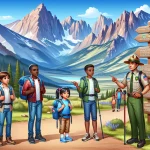Canyons of the Ancients National Monument in southwest Colorado boasts an astonishing 30,000 archaeological sites, making it the densest concentration of such sites in the United States. Established in 2000, the 176,000-acre monument preserves a wealth of cultural heritage from the Ancestral Puebloan people who inhabited the southwestern Colorado region between 750 and 1300 CE.
In This Article
TL;DR
- Canyons of the Ancients contains over 30,000 archaeological sites, including cliff dwellings, great kiva, and rock art.
- The monument offers opportunities to explore the rich cultural legacy of the Ancestral Puebloan people.
- Visitors can experience diverse outdoor recreation, including hiking trails, wildlife viewing, and unique geological formations.
Destination Overview
Canyons of the Ancients National Monument is located in the Four Corners region of Southwest Colorado, 10 miles west of Cortez and 50 miles west of Durango. Managed by the U.S. Bureau of Land Management, the monument is a must-visit destination for those interested in Southwest archaeology and Native American history. The entire region is designated as national conservation lands, ensuring their protection.
The monument’s rugged landscape of mesas and canyons is dotted with an incredible array of archaeological treasures, from cliff dwellings and kivas to intricate rock art panels. These sites provide a tangible connection to Pueblo II and Pueblo III periods when the Ancestral Puebloan cultures thrived in the region.
Archaeological Wonders
The archaeological sites within the Canyons of the Ancients are truly remarkable. The 12th-century archaeological site of Dominguez Pueblo is found here, as is the 12th-century Escalante site. Visitors can explore well-preserved cliff dwellings, offering a glimpse into the daily lives of the Ancestral Pueblo people during the Pueblo III period. Great kiva, underground ceremonial chambers, are plentiful here and showcase the spiritual practices of these ancient cultures. The monument’s rock art, including petroglyphs and pictographs, is a stunning visual record of the Pueblo people’s beliefs and traditions.
Efforts are underway to document and preserve these invaluable archaeological resources through techniques like photogrammetry and 3D laser scanning. This digital documentation ensures that future generations can continue to learn from and appreciate the rich cultural heritage of the Ancestral Pueblo. The Anasazi Heritage Center, located within Canyons of the Ancients, houses a museum where you can learn more about these efforts.
Connecting with Nature
Beyond its archaeological marvels, Canyons of the Ancients offers ample opportunities for outdoor recreation and appreciation of the region’s natural beauty. Hikers can traverse a trail network that winds through the monument’s pinyon-juniper woodlands and unveil breathtaking vistas of the American Southwest’s unique geology.
Wildlife enthusiasts may spot various species, including mule deer, golden eagles, and the iconic Colorado Plateau lizard, among the monument’s diverse flora and fauna. The rugged landscapes also provide a glimpse into the geological forces that shaped this captivating region over millions of years.
Cultural Preservation Efforts
Canyons of the Ancients is at the forefront of cultural preservation efforts, collaborating closely with Native American tribes to ensure the respectful stewardship of ancestral sites. These initiatives safeguard the physical remains and incorporate traditional knowledge and perspectives in their management.
One notable project involves documenting and preserving Euro-American historical inscriptions found within the monument. These inscriptions, often carved into rock surfaces, offer a unique glimpse into the lives of early settlers and explorers in the region. You can learn more about these preservation efforts at the Canyons of the Ancients visitor center.
Exploring the Broader Region
While Canyons of the Ancients is a remarkable destination in its own right, it is also part of a broader landscape of Southwest Colorado archaeology. Nearby sites like Mesa Verde National Park and Hovenweep National Monument provide additional insights into the Ancestral Puebloan and Basketmaker cultures.
These monuments offer a comprehensive understanding of the region’s rich cultural heritage. They showcase the interconnectedness of these ancient societies and their lasting impact on Colorado, New Mexico, and the entire American Southwest.
Heritage Tourism and Education
Canyons of the Ancients is vital in promoting heritage tourism and educational opportunities related to the Ancestral Pueblo and the American Southwest. The national monument’s visitor centers, operated by the National Park Service, and guided tours led by park rangers offer engaging ways to learn about the region’s history and cultural significance.
Heritage tourism not only fosters appreciation for the ancient cultures of the Pueblo people but also supports ongoing conservation efforts. By raising awareness and generating revenue, visitors contribute to the preservation of these invaluable federal land archaeological sites for future generations.
Conservation Challenges and Future Directions
Despite its protected status, Canyons of the Ancients faces various conservation challenges. Climate change, increased tourism, and unauthorized activities all threaten the preservation of these fragile archaeological sites.
To address these challenges, the monument’s management employs sustainable strategies and leverages technology for monitoring and conservation efforts on federal land. Initiatives like visitor education, site stabilization, and collaborative partnerships with local communities aim to ensure the long-term protection of this cultural treasure.
FAQ
What is the significance of the rock art found in Canyons of the Ancients?
The rock art panels, including petroglyphs and pictographs, provide a visual record of the Pueblo people’s beliefs, traditions, and daily life. These intricate carvings and paintings offer invaluable insights into their cultural practices and worldviews.
How can visitors experience the natural beauty of the Canyons of the Ancients?
The monument offers a hiking trail network that winds through the pinyon-juniper woodlands and showcases the unique geology of the American Southwest. Wildlife viewing opportunities also allow visitors to appreciate the region’s diverse flora and fauna.
What efforts are being made to preserve the archaeological sites in the Canyons of the Ancients?
Cultural preservation efforts include digital documentation techniques like photogrammetry and 3D laser scanning, which create detailed records of the sites. Collaborative projects with Native American tribes also ensure that traditional knowledge and perspectives are incorporated into the management and preservation of these ancestral sites.
How does Canyons of the Ancients compare to other nearby archaeological sites?
Canyons of the Ancients is part of a broader landscape of Southwest archaeology, including sites like Mesa Verde National Park and Hovenweep National Monument. These monuments offer a comprehensive understanding of the Ancestral Pueblo and Basketmaker cultures, showcasing their interconnectedness and lasting impact on the region.






